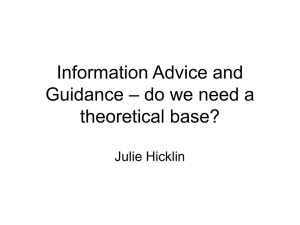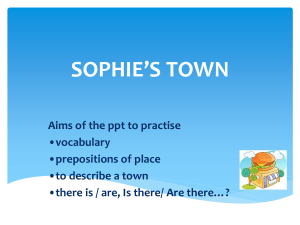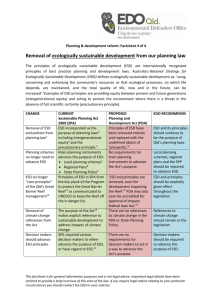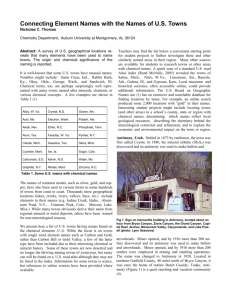Creating Sustainable Communities - School of Geography, Planning
advertisement
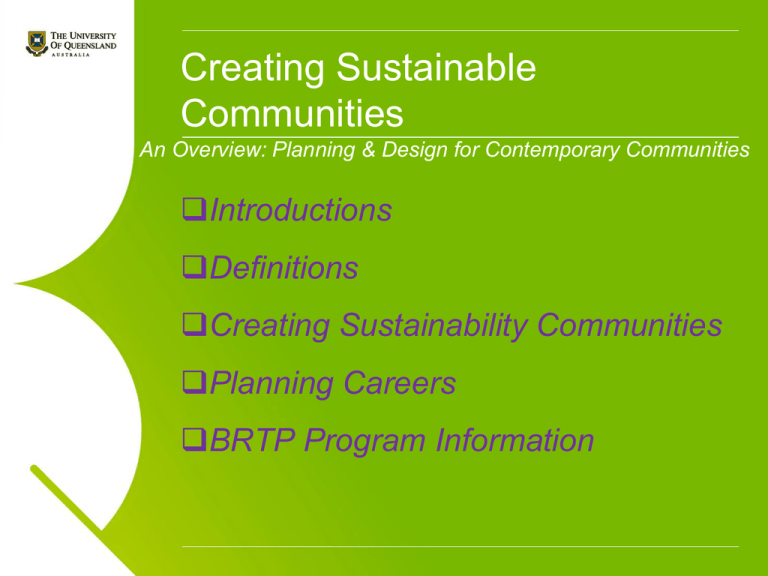
Creating Sustainable Communities An Overview: Planning & Design for Contemporary Communities Introductions Definitions Creating Sustainability Communities Planning Careers BRTP Program Information Introductions Slide sub-heading (manual text box) Laurel Johnson l.johnson3@uq.edu.au Laurel- UQ Lecturer & Private Planning Consultant Rhiannon West Rhiannon- UQ final year (Honours) student in Bachelor of Town and Regional Planning & BCC Cadet Planner & UQ Tutor DEFINITIONS SUSTAINABILITY/SUSTAINABLE • Ecologically Sustainable Development Development that improves the total quality of life, both now and in the future, in a way that maintains the ecological processes on which life depends. (Australian Government, National ESD Strategy) • Maintaining • Future generations • An aspiration Sustainable Planning Act 2009 Queensland Land Use Planning Legislation Purpose of the Act is the seek to achieve ecologically sustainable development ….(Sustainable Planning Act 2009 Chapter 1, Part 2, pp.42-44) Sustainable Planning Act 2009 Queensland Land Use Planning Legislation Ecological sustainability is a balance that integrates— (a) protection of ecological processes and natural systems at local, regional, State and wider levels; and (b) economic development; and (c) maintenance of the cultural, economic, physical and social wellbeing of people and communities. (Sustainable Planning Act 2009 Part 3, Division 2, p.45) Sustainable Planning Act 2009 Ecologically Sustainable Development ECONOMIC DEVELOPMENT Maintenance of the cultural, economic, physical and social wellbeing of people and communities SOCIAL WELLBEING Protection of ecological processes and natural systems at local, regional, state and wider levels ENVIRONMENTAL PROTECTION DEFINITION THE COMMUNITY (‘THE PUBLIC’) WHAT IS YOUR COMMUNITY? In Planning.....community is A social network of interacting individuals, usually concentrated into a defined territory (Johnston et al (eds.) (2000) The Dictionary of Human Geography, Blackwell Publishing, Malden) Communities & Planning “Not only must planners understand the characteristics and qualities of different individuals and communities; they also have a responsibility to respond to their varying needs, hopes and aspirations.” Susan Thompson (2007) Planning for Diverse Communities in Thompson S (ed.) Planning Australia: An Overview of Urban and Regional Planning , Cambridge University Press, Melbourne, pp.199-223 Planning for Diversity Communities are diverse • Age • Culture • Religion • Beliefs • Families • Abilities • Incomes • Values Do we plan for people ‘just like us’? TOWN PLANNING.... Town Planning, Land Use Planning, Spatial Planning, Urban Planning, City and Regional Planning or just plain planning Planning works to improve individual and community wellbeing by creating more convenient, equitable, healthy, efficient and attractive places for present and future generations (based on American Planning Association definition accessed at www.planning.org/aboutplanning/whatisplanning.htm). Shaping the built environment in the public interest WHY DO WE NEED PLANNING? Because Somebody Lives Here MANCHESTER 1835 Child Labourersaverage life expectancy for all citizens 18 years MODERN TOWN PLANNING Where it began Foundation in the industrial revolutionreaction to appalling living conditions – HEALTH AND SANITATION – EFFICIENCY AND ORDER – BEAUTY AND CONTACT WITH NATURE Planning & ESD – Town planning is a forward looking process that guides future development and manages land use change to shape settlements. – Town planning is an important mechanism for delivering ESD as it guides development decisions. Planners- an object of blame and hostility and the subject of hope for effective community regulation (Healey, 1997:3) Creating CommunitiesSelected Planning & Design Tools Separate incompatible land uses Provide social infrastructure-parks, recreation and community facilities Ensure employment and service access Appropriately mix land uses Deliver a range of housing types Deliver affordable and social housing Design inclusive public spaces Deliver safe environments Target areas of social disadvantage Include people in decision making Separate incompatible land uses Plan & Deliver Social Infrastructure –Standards for social infrastructure –Early delivery in new development areas • Child care • Primary school • Sport & recreation • Community meeting spaces • Public transport • Open space and movement networks • Community events and organisation Multi-Purpose Social Infrastructure Parks, open space and recreation Accessible employment and services Appropriate mix of land uses (scale) Mixed housing in local areas Involve Communities in Planning Target areas of social disadvantage • Apply Indices of disadvantage to target areas • Specific Interventions relevant to needs and local values/issues Identity & Pride Crime Prevention Through Environmental Design (CPTED) Code/Guidelines Child & Youth Friendly City Design Guidelines Include the Voiceless, Marginalised, Excluded • Social (or Community) Impact Assessment • Set Development Parameters • % of family dwellings in medium and high density residential configurations • Design of medium and high density units to accommodate children (outdoor play areas etc) Community Building • Spatial strategies for creating and sustaining communities AND • Community building offers complementary strategies such as: –Community Development (creating connections) –Community Governance (organisations and spaces) –Community Engagement (ongoing) Planning Careers A Range of Specialties in Planning Strategic Planning Transport Planning Environmental Planning Infrastructure Planning Social Planning Community Planning Parks and Open Space Planning Urban Design Development Assessment Policy Development Planning Law Planning Education & Research Planning Careers Employers Public Sector Commonwealth, State and Local Government Private Sector Development Companies Consultancy firms Resource sector Non-Government Sector International Non-Government Organisations Planning Careers Locations International possibilities (NGOs, & Consultancy firms) Demand in regional and rural areas (State & Local Government & Consultancy firms) Demand varies in City areas, depending (to some extent) on land development cycles Planning Graduate Stories Stephanie Wyeth Director, Social Planning URBIS National PIA award for Child and Youth Friendly Redlands project Driven by a strong sense of social justice and a desire to create safe, fun neighbourhoods for kids and families Passionate about creating communities through planning and design Planning Graduate Stories Guy Gibson Director, Lend Lease He sees a new path opening up for future graduates of the discipline. “There is a huge opportunity for planning students to look at the potential of new media to communicate and consult better with local communities to provide clear guidance to development proponents and enable more efficient assessment of their proposals. This is something that the current practitioners of the profession are unfortunately neglecting”. It was a love of Geography in high school set Guy on the route to become an urban planner and his studies at UQ laid the foundations for his career. Guy Gibson UQ- BRTP Program Opening Doors to a Planning Career 4 year undergraduate program Same cohort of students throughout the 4 years Fixed program with some elective (some choice) For high achievers, option to do a 1 semester research project (Honours) BRTP Pre-requisites • http://www.gpem.uq.edu.au/bachelor-regional-town-planning • Year 12 English • OP 12 (2012) • Intake 80 domestic students • 20 International students (varies according to demand) BRTP Program- Uni Life Pre-requisites OBSERVATIONS Challenges for first year BRTP studentsconceptualising planning writing & research skills and group work Lecture Review Slide sub-heading (manual text box) Definitions Town planning strategies for creating communities Planning Careers UQ Graduate Planners BRTP Program Lecture References • American Planning Association website accessed at www.planning.org • City Plan 2000 website accessed at www.brisbane.qld.gov.au • P Healey (1997) Collaborative Planning: shaping places in fragmented societies, Palgrave, Hampshire • PIA (Qld Division) website accessed at www.planning.org.au • Sustainable Planning Act 2009 website accessed at www.dlgp.qld.gov.au CREATING A SUSTAINABLE COMMUNITY WORKSHOP 2 Activities 1. How Sustainable is Your Neighbourhood? 2. Childhood Memories THANK YOU & ENJOY LUNCH See you back in this room at 12.30pm


